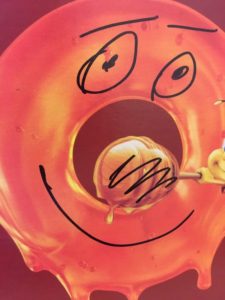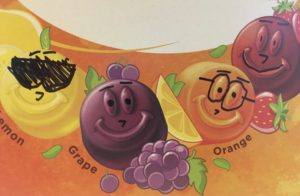Have you ever read a sign wrong and liked it better that way? Our family went “rustic camping” a couple of weeks ago, and we passed a notice by the road that said “You are responsible for your refuse”. This usually means, “Hey, pick up your trash, kid.” but I saw “refuse” for its literal meaning – to be unwilling to do something.
My gears started to shift.
Things happen in life. Whether it’s an opportunity that comes my way or a problem that blocks my path, no one can force me to change. But if I choose not to grow, take risks, and make the next move forward (however scary) then I need to take responsibility for my choice.
I am responsible for my refuse.
Most of the time, I don’t think we realize when we are refusing to change. For me, sometimes I get into a routine that works, and I think I’m all set. After all, if someone isn’t inviting you to jump into a cold lake, are you really refusing to go?
Of course, there are times when refusing to do something is a good thing. Not every opportunity can or should be taken. But I have refused so many good things in life.
I have refused to believe. Refused to put the work in. Refused to give someone a chance.
Those devastating refusals are on no one else besides me. But I don’t have to stay in a state of quiet or constant refusal. And if I am responsible for my refuse, then that means I also have the ability to change it. The transformation could be amazing, if I refuse to doubt.
You are responsible for your refuse. The question is: What are you going to do with it?
Until next time,
Invent your story
Escape rooms have become incredibly popular – and they’re not just for adults. At the library, we often get requests from kids to do an escape room, and we love to make it happen because they’re fun! If you know kids who love thinking outside the box and cracking codes, then an escape room is an excellent challenge you can create for them anytime.
Idea #1: Make a Puzzle Code
I recently made an escape room for elementary-aged kids at my house, and one of the codes they had to crack was a puzzle code. I had a 24-piece puzzle in the room, and on the back of it, I wrote one of the codes they needed to escape the room.
Finding the code on the puzzle was a challenge for them, but the greater difficulty was putting the puzzle together upside down once they found it! I had planted tape in the room so the kids could make the puzzle right-side up, tape it, and flip it – but they solved it their way and that’s awesome.
Idea #2: Build a Bubble Veil
If you’re using a bathroom as one of the rooms in your game (we had the kids go between two rooms of the house) then a bubble veil is a fun surprise! I painted a code on a rock, and then placed it in the bottom of the tub with a bunch of other rocks. After adding dish soap and water, all of the rocks disappeared under the bubbles – and the kids had fun fishing for the code.
Idea #3: Create a Chemical-Reaction Code
This one took the longest for the kids to figure out, but when they did, they were thrilled. I made a baking soda-and-water paste, and I wrote the code (using the paste) on a white piece of paper. Once it was dry, the code was pretty hard to see – especially when I put the “special paper” in a pile of other white papers. In another area of the room, I hid a pipette and small container of grape juice. Once the kids found the materials, they put the juice on the message cracked the code!
I hope you have fun creating your escape room. I love the way this exercise encourages kids to look at their environment differently, experiment, and think in an inventive way. Who knows what they’ll take and make next?
Until next time,
Invent your story
Getting Organized: Do What Works for You
If I’ve learned anything in my creative endeavors with friends, it’s that we all have a different way of doing things. Some writers plot out their stories. Some writers fly by the seat of their pants. Some people build a puzzle starting with the edge pieces, and other puzzlers start in the middle.
Finding out what works for you is the key to staying motivated with a project.
There’s not a right or wrong way to fold towels. There’s not a right or wrong way to organize an invention center. But it is important to take a little bit of time, consider your organizational style, and put your space together the way you like it.
What makes your creative spirit happy?
Do your insides sing when you see alphabetized DVD’s? Do bins in coordinating colors make you relax and want to create something new? Do quotes by your favorite inspirational leaders keep you moving forward? Let those answers direct how you move forward organizing your invention center.
I recently edited a book by the popular lifestyle blogger Sarah Symonds called Designing a Life: From House to Haven. The bit of magic she unlocks in her book changed my perspective on home décor forever. She uses a 10-step method to help individuals discover their creative style and use it to turn their home into a place of refuge. I highly recommend her book, and I’m applying her principles as I build my invention center. [Noteworthy: I don’t receive financial compensation for pitching Sarah’s book – I just found in genuinely useful and wanted to share it. Also, my center doesn’t reflect her style.]
What fuels my creative spirit?
Junk.
Even better?
Junk inside of junk.
In my invention center, I have a shoebox full of toilet paper rolls ready and waiting. Old grapefruit containers are filled with rocks. Acrylic paint is splattered on the table, and the table itself is made of uneven boards and 2×4’s that I cut in straight (warped) lines with a scroll saw.
If you’ll please notice in the featured picture, the top of the table doesn’t match or fit the bottom. And the cat photobombing my art habitually scatters the oh-so-nicely placed scissors and pliers. I’ll be the first to admit it: my center does need a chair. But it’s my happy place, and I wouldn’t change a thing.
Let your invention center be your happy place, and just do what you do. Because there’s no one in the world who can invent exactly like you.
Until next time,
Invent your story
I can’t take credit for the cool faces on all of these boxes. I have an artist in my home who learned this technique from a buddy. Since my son took it up, our home has exploded with fun faces that bust up the doldrums of household routines.

Just for giggles, here’s my how-to tutorial for Cereal Box Sharpie Art:
1.) Choose a cereal (or other) box.
2.) Grab a sharpie.
3.) Get creative.

How long has it been since you’ve given yourself complete creative freedom? When was the last time you recklessly abandoned the rules and thought, “What else could this be?” The ingenuity of this art form is its out-of-the-box thinking. Sorry guys, it just had to be punned.
Just in case you think I’m off my rocker, I’ll let you in on a little secret: I’m not a super-great artist. I love art, and I marvel at the classic, great artists who’ve earned every bit of their fame. But I am not, and will never be, one of those men or women.
I’m more of an “art-inspires-me-so-I-create” kind of artist. A lot of my work is just odd. I like it that way. But why in the world do I put it online for you to see and try for yourself?
Here’s the thing: I don’t care what category your profession falls under – healthcare, hospitality, computer software development, or waste management – every job needs innovative thinking. Are faces on cereal boxes innovative? Maybe, but they definitely shake things up, and they’re reminders.
Reminders that things can change.
So, if you’re stuck in any way, shape, or form in life, grab a sharpie and a box. Change it up! Remind yourself that even good things can be a little brighter when you add your creative thinking to them.
Until next time,
Invent your story

This seems like the easy part of creating an invention center – you just get the supplies you need. The thing is, without a method to the madness, it’s just madness. So here are three plumb line questions to keep you stockpiling instead of just making piles.
Does the material fit into the goal of your invention center?
I know I haven’t brought up the term “goal” in the context of your invention center before, but if you’ve come this far, you probably have a good idea of what yours is already. (If you haven’t read the first two posts on creating an invention center, you can read what it is and Part 1 to get caught up.) If you’re woodworking, you’ll need wood, screws, a drill, etc.
This is the no-brainer stuff to have around. Without a stocked area, you’ll get bogged down looking for that lost paintbrush or copper wire. This is why we’re making an invention center.
How much do you need to get started?
Sometimes the zeal to create can take over, and you end up with a lot more than you need – especially if it’s freebie stock. Like toilet paper rolls. There are tons of art and engineering projects you can do with toilet paper rolls. But if you keep saving and don’t use them, well it can just start to get weird.
There has to be a FULL point. Then move on.
Did you throw a wrench in your plan?
If the answer to the last question is “nope” – then it’s time to find that wrench and throw it into the stockpile! Hear me out on this one. If you want to create a maker’s space, that’s great, but this is a defining moment for your invention center. You want to have something in your invention center that challenges you to break the mold. More than something. A fair lot of things. An acorn from last fall’s hike. A bunch of rusty nails. One red sock.
These are the grains of sand that help your creative oyster make a pearl.
Until next time,
Invent your story
Rejection. It’s not really the part of the writer’s life that’s fun to talk about. It’s great writing material – rejection involves conflict! Rejection is interesting! Rejection is an obstacle for the protagonist to overcome!
Rejection stinks.
Sure, it’s expected. Even the extremely successful writers are criticized and rejected by people – or their work is. And it’s a wonderful teacher (that’s for another post). I don’t expect everyone to like my work, but I do hope somebody does.
And since my last post on writing, somebody did. I mentioned WOW – Women on Writing last time because I’d submitted my work to their competition and knew I was a finalist. They liked my work – the question was, would I be a winner?
Drum roll, please….
Runner-up! My story As for Adventure was one of the top ten stories for their Spring 2018 Flash Fiction contest, and it’s so weird to be writing the words you can read my published work by clicking here. You really can. This actually happened.
Every one of us has a story and experiencing this part of mine makes me want to thank everyone in the world who helped me. Because this is something I could never do on my own. I’m thankful to God, my parents who encouraged me, my sisters who’ve always had my back, my husband who’s in my corner, my kids who genuinely care, my amazing friends who’ve walked with me in life, my teachers who gave me tools and encouragement along the way – thank you so much. Without you, I wouldn’t be doing what I do. And so many thanks to WOW with guest judge literary agent Sharon Pelletier of Dystel, Goderich & Bourret. If writers didn’t have opportunities like this one, we’d be missing the challenges that help propel us forward. Thank you!
Because this is my first “real success” as a writer, there’s a something I want to share with you that I hope make a difference for someone out there.
I joined a writing group almost two years ago. My first night there, I brought a poem with me, and I was terrified to read it. Terrified, but I knew if I was really going to do this writer thing, I needed to face that fear.
Before I could get the words out, I said:
This is stupid. This is so stupid.
Then I read it. A leader pointed out some of the poem’s strengths and where it could be improved. People liked it well enough, and I was excited to come back to group again – but in the parking lot afterward, a girl came up to me and said
Don’t ever, EVER call your work stupid.
And since that day, I never have. Because it’s not stupid. I don’t approach writing lightly, and I think most writers don’t. My writing group has weathered many rejections with me. Some of my dear friends edited the winning story for me before submission. And this month, when I walked in the door, the entire group burst into applause to celebrate my placement in WOW’s competition. They are amazing people who I love.
If you’re a writer and you’re not connected with other writers, you are missing out. My writing group helped move me from rejecting my own work, to learning how to weather rejection from others, to celebrating success.
Who you journey with makes all the difference.
Until next time,
Invent your story
If you want to follow some of my amazing writer friends who helped improve my story, check out their websites here!
